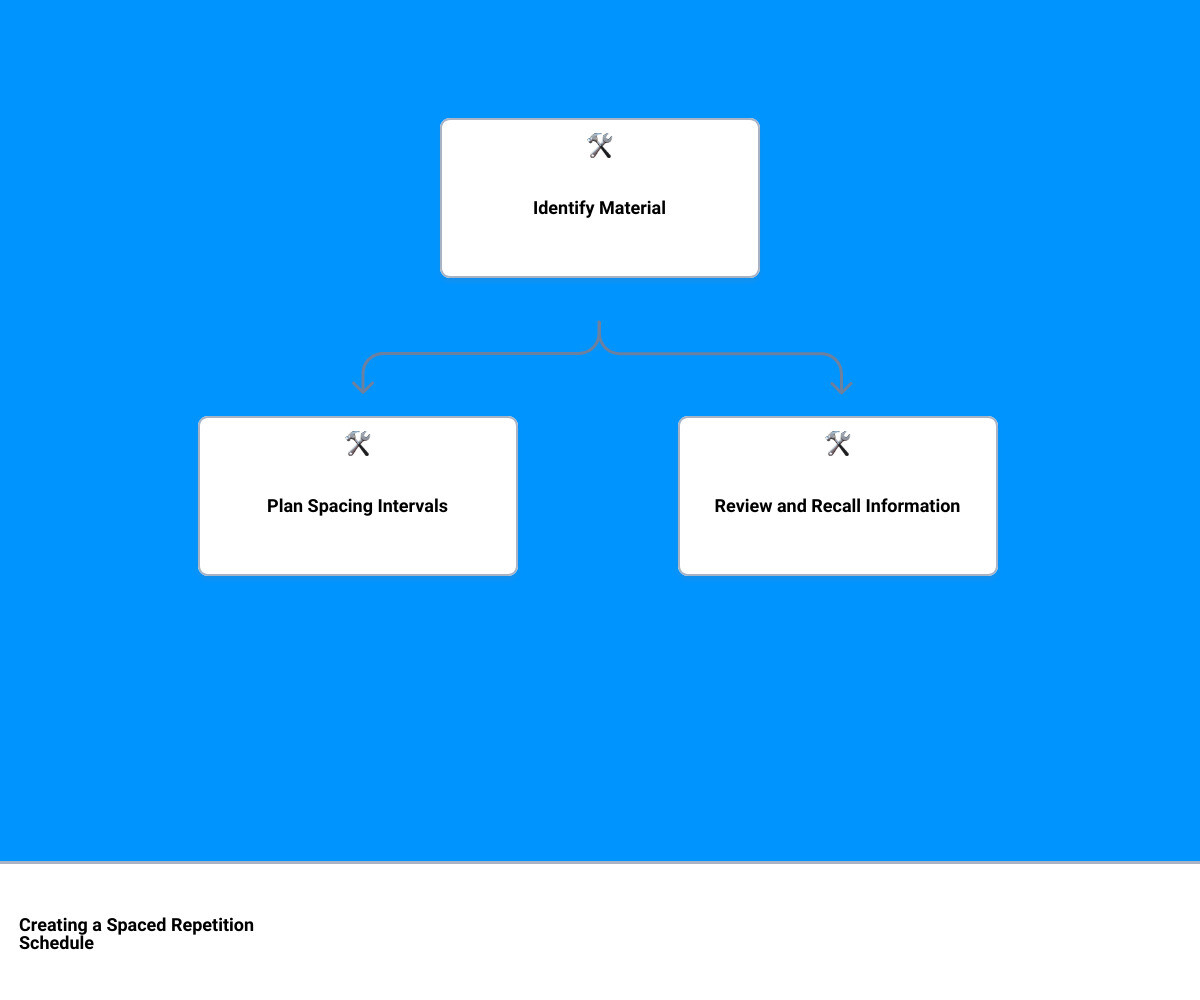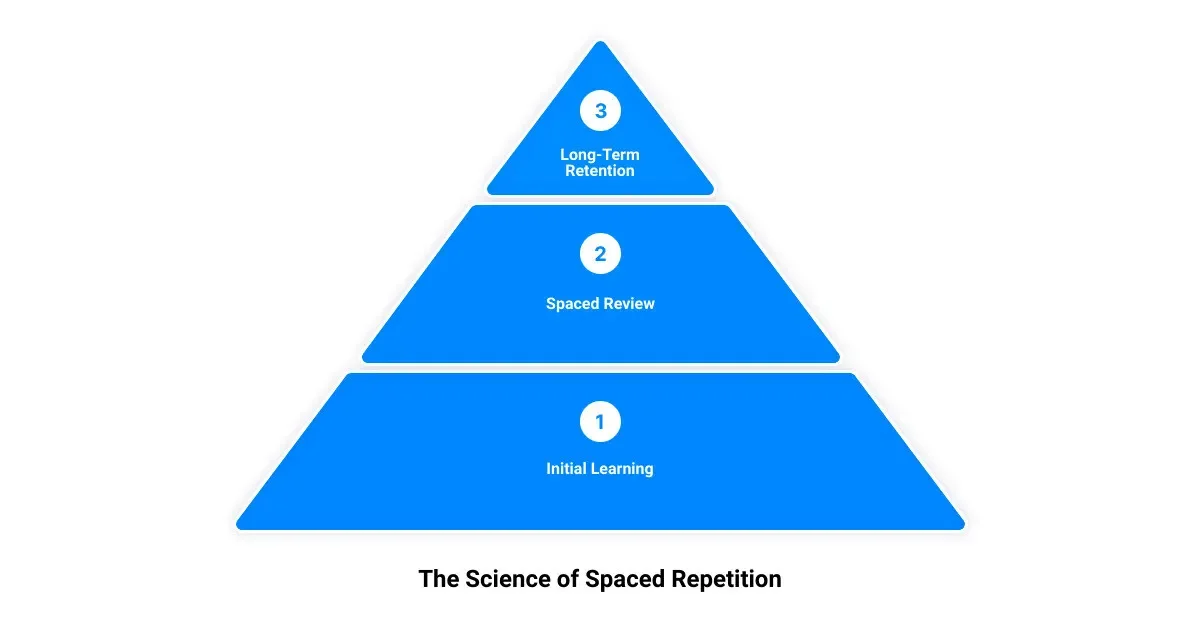Imagine being able to remember more, learn faster, and truly retain information. That's the power of spaced repetition, a science-backed method for effective learning. This technique leverages the cognitive science principles of the Forgetting Curve and the Spacing Effect to optimize recall and retention, transforming the way we learn. Whether you're mastering Mandarin Chinese or any other subject, understanding and implementing a smart study schedule with spaced repetition can unlock your full learning potential. In this article, we will guide you on how to create a spaced repetition schedule, backed by both research and practical examples, to help you master the art of remembering.
Understanding Spaced Repetition: The Science Behind the Technique
Just as a sculptor chisels away at a block of marble to reveal a masterpiece, let's chisel away the complexities of spaced repetition to expose the science that crafts it into an effective learning technique.
At its core, spaced repetition rests on the firm foundation of the spacing effect, a principle that suggests our brains absorb information more efficiently when our study sessions are spread out over time. Think of learning as building a brick wall. If you stack the bricks too quickly without giving the mortar time to solidify, the wall won't be sturdy. By spacing out our learning, we allow our mental 'mortar' to dry, thereby strengthening our knowledge.
To dig deeper into the workings of memory, let's explore two vital concepts: storage strength and retrieval strength. Storage strength refers to the depth at which information is embedded in our memory. This strength doesn’t diminish over time and only increases through repeated recall or use. On the other hand, retrieval strength pertains to how readily we can access that memory. Unlike storage strength, retrieval strength fades over time unless maintained through regular recall. Picture your brain as a massive library. Storage strength is the permanence of the books on the shelves, while retrieval strength is the effectiveness of your library's catalog system. To find a specific book (or memory), you need a well-maintained catalog, underscoring why regular recall is crucial.
Now, let's consider the Forgetting Curve, a concept developed by pioneering memory researcher Hermann Ebbinghaus. This curve illustrates how memories fade over time without efforts to retain them. However, reviewing the information at strategic intervals can 'reset' the curve and slow down memory decay. This discovery laid the foundation for spaced repetition, where timely reviews are used to bolster memory retention.
For our lifelong learners striving to master Mandarin, this means regularly revisiting new vocabulary and grammar rules at specific intervals can help you retain this information long-term.
The magic of spaced repetition lies in this intricate blend of the spacing effect, the dual strength theory, and the Forgetting Curve. By understanding and leveraging these principles, we can unlock our brain's true learning potential, making spaced repetition a powerful tool in your Mandarin learning journey.
The Role of Spaced Repetition in Memory Retention
Unleashing the power of your memory is like discovering a hidden treasure. One such gem in the realm of effective learning is Spaced Repetition, a technique that employs cognitive science principles to boost memory recall and retention. But what exactly is the role of spaced repetition in memory retention, and how does it work? Let's delve into the fascinating science behind this method.
Spaced Repetition: Fighting the Forgetting Curve
Imagine learning a new Chinese character. Initially, the image is crisp and clear in your mind. But with time, the memory starts to fade, akin to a photo left in the sun. This fading of memory over time, especially for newly learned information, is known as the Forgetting Curve, a concept developed by 19th-century psychologist Hermann Ebbinghaus.
Without review, our memory of new information decays quickly at first and then levels off over time. Sounds gloomy, doesn't it? But here's where spaced repetition comes to the rescue. By revisiting the material just before you're about to forget it, spaced repetition resets the Forgetting Curve and slows down memory decay. Each review strengthens the memory, extending the time it takes for the information to fade.
The Spacing Effect: Solidifying the Mental 'Mortar'
Spaced repetition also leverages the Spacing Effect, which suggests that our brains learn more efficiently when we spread out our study sessions over time. It's comparable to allowing the mental 'mortar' to dry, solidifying new knowledge, and making the learning process more effective.
This concept goes hand in hand with Robert Bjork's principle of desirable difficulty, which proposes that learning is most effective when it's challenging, but not too hard. Spaced repetition, with gradually increasing review intervals, provides just the right balance of challenge to keep our brains engaged and our learning optimized.
The Dual Strength Theory: Storage Vs Retrieval Strength
Another layer to the understanding of memory is Benedict Carey's dual strength theory, which elucidates that memories have two strengths: storage and retrieval.
Storage strength refers to how well the information is embedded in our memory. It doesn't fade over time, but can only be increased through repeated recall or use. Retrieval strength, on the other hand, pertains to how easily we can access that memory. Unlike storage strength, retrieval strength does fade over time unless maintained through regular recall.
The Building Blocks of Effective Learning
Understanding the role of spaced repetition in memory retention is like assembling the building blocks of effective learning. By leveraging the Forgetting Curve, the Spacing Effect, and the dual strength theory, we can harness the full potential of our brains and transform the way we learn and remember. Whether you're mastering Mandarin Chinese or any other subject, spaced repetition is your secret weapon to boost recall and retention. With the science of spaced repetition at your fingertips, every study session becomes a step toward efficient, long-term learning.
In the next section, we'll dive into a step-by-step guide on how to create a spaced repetition schedule to maximize these benefits.

How to Create a Spaced Repetition Schedule: A Step-by-Step Guide
Creating a spaced repetition schedule might seem challenging, but it's simpler than you think. By following this five-step guide, you can optimize your learning process and make the most of your study sessions.
Step 1: Identify the Material to Study
The first step is to identify what you need to study. Whether it's Mandarin vocabulary or complex concepts, you need to have a clear idea of what you will be focusing on during your study sessions. Prioritize high-yield material that is most likely to appear in exams or that you find most difficult to remember.
Step 2: Plan Your Spacing Intervals
Once you've identified your study material, the next step is to plan your spacing intervals. Dr. Piotr Wozniak's research suggests that the first repetition should occur one day after initial learning, the second repetition after seven days, the third repetition after 16 days, and the fourth repetition after 35 days. These intervals align with our brain's natural forgetting curve, allowing us to engage with the material right as we're about to forget it, thereby reinforcing the memory.
Step 3: Review and Study the Information
With your material and intervals set, it's time to review and study the information. This initial review should be thorough, ensuring you understand the concepts before you start the repetition process. Remember, repetition strengthens existing memories, so make sure you have a good grasp of the content during the first study session.
Step 4: Recall the Information at the First Spacing Interval
After your initial study session, the first recall should occur at the interval you set in step two. This is where the magic of spaced repetition starts to shine. You'll be recalling the information just as your memory begins to fade, reinforcing your learning and making the information stick.
Step 5: Continue Recalling the Information at Chosen Intervals
The final step is to continue recalling the information at your chosen intervals. Stick to your schedule, trust the process, and remember that spaced repetition is a long-term strategy. It might seem slow at first, but with time and consistency, you'll start to see improvements in your recall speed and memory retention.
Creating a spaced repetition schedule is a dynamic process. As you become more familiar with your own learning pace and style, feel free to adjust your intervals and study sessions to better suit your needs. The goal is to make your study sessions as effective and efficient as possible, setting you on the path to mastering Mandarin or any other subject you're learning.

Spaced Repetition Schedules: Examples and Best Practices
A well-crafted spaced repetition schedule can be a game-changer in your learning journey, whether you're learning Mandarin or any other subject. Let's take a look at two popular schedules and some best practices to make the most out of your study sessions.
Example 1: Dominic O'Brien's Review Schedule
World memory champion Dominic O'Brien offers an effective approach to spaced repetition. This schedule involves reviewing material immediately after learning, then after 24 hours, one week, one month, and finally three months. While it's a more condensed schedule, it's especially useful when preparing for exams or for learners who want to retain information over a shorter timeframe.
Example 2: Paul Pimsleur's Intervals for Language Learning
If you're mastering a new language like Mandarin, consider adopting Paul Pimsleur's intervals. These intervals start from as little as 5 seconds and can go up to 2 years, depending on the complexity of the language and your familiarity with it. This gradual progression and continual reinforcement of the material is particularly effective for language learners.
Best Practice: Balancing Success and Error Rates
Spaced repetition is most effective when you practice at a level where there's a balance between your success and error rates. If you're easily recalling all information, you're no longer actively using your brain to retrieve information. On the other hand, if you're constantly making errors, the intervals might be too long. Adjust your schedule to find the sweet spot.
Best Practice: Sticking with the Schedule
It might seem challenging at first, but stick with your schedule despite any rough patches. These challenging moments are invaluable as they will help strengthen your neural pathways over time. Remember, spaced repetition takes time to show results, but once it does, you’ll appreciate your efforts.
Best Practice: Setting Up a Comfortable Study Environment
Your study environment plays a significant role in your learning journey. A well-organized, distraction-free, and comfortable space can enhance your focus and productivity. Make sure everything you need is within reach, and you’ll find your spaced repetition sessions to be more effective.
Incorporating these best practices and schedules into your learning routine can elevate your study sessions, making them more productive and enjoyable.

Using Spaced Repetition with Traverse: A Powerful Learning Tool
Taking your learning to new heights is possible with Traverse, a tool that innovatively combines spaced repetition with other powerful learning strategies. With Traverse, the journey to mastering Mandarin, or any complex topic, becomes more efficient and enjoyable.
Importing Anki Decks into Traverse
If you have been using Anki for your Mandarin learning, or indeed for any subject, there's no need to worry about leaving behind your carefully curated flashcards. Traverse provides a seamless transition with its 100% Anki-compatible feature. This compatibility allows you to import your Anki decks into Traverse and pick up exactly where you left off. The transition enables you to continue your learning without missing a beat, while also taking advantage of the advanced features Traverse offers.
Using Traverse for Mandarin Learning with Mandarin Blueprint
Learning Mandarin, with its intricate characters and tones, can be challenging. But Traverse, with its spaced learning approach, transforms this challenge into an engaging journey. With its interactive platform, Traverse offers an enjoyable way to study and review Mandarin characters, allowing you to understand their usage and remember them more effectively.
By incorporating spaced learning, Traverse breaks down the complexity of Mandarin characters and tones into manageable chunks. This approach prevents cognitive overload, making Mandarin learning more efficient and fun. Each character is introduced and repeated in various contexts, facilitating a deep understanding and long-term retention of its usage.
Moreover, Traverse uses active learning to encourage engagement and track progress. Integrating interactive elements like quizzes not only keeps the learning process exciting but also helps reinforce the knowledge you've gained.
With Traverse, you're not just learning Mandarin - you're mastering it. The tool's advanced features coupled with the power of spaced repetition offer an effective strategy to supercharge your Mandarin learning journey. So why stick to old cramming techniques when you can enhance your learning and memory retention with the spaced learning method and Traverse? The power to master Mandarin is within your reach.
Conclusion: Unlock Your Full Potential with a Smart Study Schedule
In the vast landscape of learning strategies, few stand out as remarkably as spaced repetition. Harnessing the power of cognitive science, this approach is a game-changer for learners eager to maximize their efficiency and boost long-term memory retention. When you're learning something as complex and fascinating as Mandarin, leveraging the strengths of spaced repetition is a must.
But remember, the key to unlocking the full potential of this technique lies in the consistent application of your study schedule. Stick to your planned intervals, continually review your material, and engage in meaningful recall. This is your key to combating the forgetting curve and embed memorable information into your long-term memory. It might seem challenging at first, but with time and practice, you'll find yourself remembering more than you ever thought possible.
It's also important to remember that learning is a journey, not a destination. With any journey, the path might get rocky at times, but don't let that discourage you. When you stumble, pick yourself up, dust yourself off, and continue moving forward. After all, every challenge you overcome on your journey just makes the final destination that much sweeter.
So, if you're ready to take your learning to the next level, it's time to embrace the power of spaced repetition and create your smart study schedule. Combine it with a powerful tool like Traverse, and you've got yourself a winning formula for mastering Mandarin or any other language or subject you're studying.
Now, it's time for you to unlock your full potential and start your journey towards effective and efficient learning. You've got the tools, the strategies, and the will to succeed. All that's left is to get started. Happy studying!

